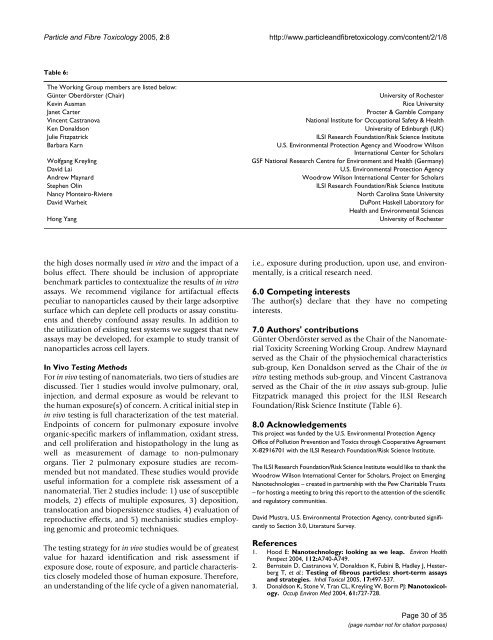Particle and Fibre Toxicology - Nanowerk
Particle and Fibre Toxicology - Nanowerk
Particle and Fibre Toxicology - Nanowerk
Create successful ePaper yourself
Turn your PDF publications into a flip-book with our unique Google optimized e-Paper software.
<strong>Particle</strong> <strong>and</strong> <strong>Fibre</strong> <strong>Toxicology</strong> 2005, 2:8<br />
http://www.particle<strong>and</strong>fibretoxicology.com/content/2/1/8<br />
Table 6:<br />
The Working Group members are listed below:<br />
Günter Oberdörster (Chair)<br />
Kevin Ausman<br />
Janet Carter<br />
Vincent Castranova<br />
Ken Donaldson<br />
Julie Fitzpatrick<br />
Barbara Karn<br />
Wolfgang Kreyling<br />
David Lai<br />
Andrew Maynard<br />
Stephen Olin<br />
Nancy Monteiro-Riviere<br />
David Warheit<br />
Hong Yang<br />
University of Rochester<br />
Rice University<br />
Procter & Gamble Company<br />
National Institute for Occupational Safety & Health<br />
University of Edinburgh (UK)<br />
ILSI Research Foundation/Risk Science Institute<br />
U.S. Environmental Protection Agency <strong>and</strong> Woodrow Wilson<br />
International Center for Scholars<br />
GSF National Research Centre for Environment <strong>and</strong> Health (Germany)<br />
U.S. Environmental Protection Agency<br />
Woodrow Wilson International Center for Scholars<br />
ILSI Research Foundation/Risk Science Institute<br />
North Carolina State University<br />
DuPont Haskell Laboratory for<br />
Health <strong>and</strong> Environmental Sciences<br />
University of Rochester<br />
the high doses normally used in vitro <strong>and</strong> the impact of a<br />
bolus effect. There should be inclusion of appropriate<br />
benchmark particles to contextualize the results of in vitro<br />
assays. We recommend vigilance for artifactual effects<br />
peculiar to nanoparticles caused by their large adsorptive<br />
surface which can deplete cell products or assay constituents<br />
<strong>and</strong> thereby confound assay results. In addition to<br />
the utilization of existing test systems we suggest that new<br />
assays may be developed, for example to study transit of<br />
nanoparticles across cell layers.<br />
In Vivo Testing Methods<br />
For in vivo testing of nanomaterials, two tiers of studies are<br />
discussed. Tier 1 studies would involve pulmonary, oral,<br />
injection, <strong>and</strong> dermal exposure as would be relevant to<br />
the human exposure(s) of concern. A critical initial step in<br />
in vivo testing is full characterization of the test material.<br />
Endpoints of concern for pulmonary exposure involve<br />
organic-specific markers of inflammation, oxidant stress,<br />
<strong>and</strong> cell proliferation <strong>and</strong> histopathology in the lung as<br />
well as measurement of damage to non-pulmonary<br />
organs. Tier 2 pulmonary exposure studies are recommended<br />
but not m<strong>and</strong>ated. These studies would provide<br />
useful information for a complete risk assessment of a<br />
nanomaterial. Tier 2 studies include: 1) use of susceptible<br />
models, 2) effects of multiple exposures, 3) deposition,<br />
translocation <strong>and</strong> biopersistence studies, 4) evaluation of<br />
reproductive effects, <strong>and</strong> 5) mechanistic studies employing<br />
genomic <strong>and</strong> proteomic techniques.<br />
The testing strategy for in vivo studies would be of greatest<br />
value for hazard identification <strong>and</strong> risk assessment if<br />
exposure dose, route of exposure, <strong>and</strong> particle characteristics<br />
closely modeled those of human exposure. Therefore,<br />
an underst<strong>and</strong>ing of the life cycle of a given nanomaterial,<br />
i.e., exposure during production, upon use, <strong>and</strong> environmentally,<br />
is a critical research need.<br />
6.0 Competing interests<br />
The author(s) declare that they have no competing<br />
interests.<br />
7.0 Authors' contributions<br />
Günter Oberdörster served as the Chair of the Nanomaterial<br />
Toxicity Screening Working Group. Andrew Maynard<br />
served as the Chair of the physiochemical characteristics<br />
sub-group, Ken Donaldson served as the Chair of the in<br />
vitro testing methods sub-group, <strong>and</strong> Vincent Castranova<br />
served as the Chair of the in vivo assays sub-group. Julie<br />
Fitzpatrick managed this project for the ILSI Research<br />
Foundation/Risk Science Institute (Table 6).<br />
8.0 Acknowledgements<br />
This project was funded by the U.S. Environmental Protection Agency<br />
Office of Pollution Prevention <strong>and</strong> Toxics through Cooperative Agreement<br />
X-82916701 with the ILSI Research Foundation/Risk Science Institute.<br />
The ILSI Research Foundation/Risk Science Institute would like to thank the<br />
Woodrow Wilson International Center for Scholars, Project on Emerging<br />
Nanotechnologies – created in partnership with the Pew Charitable Trusts<br />
– for hosting a meeting to bring this report to the attention of the scientific<br />
<strong>and</strong> regulatory communities.<br />
David Mustra, U.S. Environmental Protection Agency, contributed significantly<br />
to Section 3.0, Literature Survey.<br />
References<br />
1. Hood E: Nanotechnology: looking as we leap. Environ Health<br />
Perspect 2004, 112:A740-A749.<br />
2. Bernstein D, Castranova V, Donaldson K, Fubini B, Hadley J, Hesterberg<br />
T, et al.: Testing of fibrous particles: short-term assays<br />
<strong>and</strong> strategies. Inhal Toxicol 2005, 17:497-537.<br />
3. Donaldson K, Stone V, Tran CL, Kreyling W, Borm PJ: Nanotoxicology.<br />
Occup Environ Med 2004, 61:727-728.<br />
Page 30 of 35<br />
(page number not for citation purposes)
















